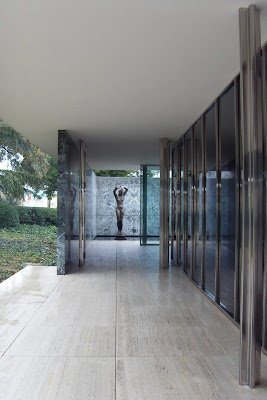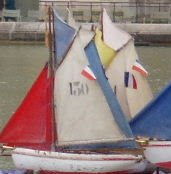Thursday, February 25, 2010
mies barcelona-exterior
It was sublimely exhilarating to float through this piece of "constructivist sculpture" conceived over eight decades ago now by that most rigorous of German architects, Ludwig Mies van der Rohe, for the Barcelona International Exposition in 1929 [and faithfully reconstructed in 1986 on its original site as a lasting monument to the International Style in modern architecture] ...
I stepped lightly upon an altar of Roman travertine, transversed by planes of metal framed glass and panels of green Alpine marble and golden onyx from the Atlas Mountains...and entered a minimalist shrine of asymmetrical spatial flow contained by exquisite materials gleaming, reflecting, uplifting in the ever changing light...
the enticing nude [that has been referred to alternatively as "Amanecer"/"Alba"/"Morgen"/"Dawn" by the German sculptor Georg Kolbe, 1877-1947], embraced by the hallucinatory marble walls, is a curvaceous yet solid antependium inserted in this corner of the altar exposed to the hard rays of the summer sun and the soft rains of winter...
the ablution sheet of water in the black marble pool is gently rippled by fresh drops of rain and the stray fallen leaf...
small seas of light and dark soundlessly bound the pavilion front and back with the tranquil and poetic reflection of water playing off the polished glaze of fossilized stone...
I traversed along stretches of pale travertine still glistening from the rain and framing lush foliage...
enclosed by immutable precision, by luminous fluidity, by exacting ideology, by an odd sense of purity...
I remember looking at grainy black and white photographs of this pavilion reproduced in my old copy of Vincent Scully's Modern Architecture when I was a Fine Arts student taking some courses in architectural history - and these were images of the original structure from 1929 as it was soon demolished after the exposition...
[it was cool to realize that the shot below of the view from the end of the front court is almost identical to one in the book!]
I was on hallowed ground of one of modern architecture's most numinous pantheon and we were alone under the gray muted skies of Barcelona, taking hushed steps towards a beckoning "Dawn" in the consecrated distance...
Av. Marquès de Comillas s/n, Parc de Montjuic, 08038 Barcelona
"No work other than the Barcelona Pavilion could symbolize the still fresh possibilities of a modern language of architecture. To the extent that modernism's supposed "coldness" had become a postmodern cliché, Mies's sensuous materials - red silk curtains, four different types of plate glass, and stone surfaces of golden onyx, Roman travertine, and green Alpine marble - fairly startled the eyes of those who had only known the structure from black-and-white photographs. Equally in keeping with the mood of the day were the spatial ambiguities and the palpable juxtapositions of the human figure - both the female nude of Georg Kolbe's statue The Dawn and the visitor's - with myriad abstract reflective surfaces. Given the particular vibrancy of that part of contemporary architecture in Spain that is directly or indirectly influenced by Mies's classic Minimalism - with new found associations of material and spatial sensuousness - it is hard to deny the importance of the Barcelona Pavilion's somewhat ahistorical reappearance. As if having arrived directly from the more radical moment of its creation, it exists as a negation of the International Style's subsequent dilutions and presents itself as a fresh point of departure."*
[*from page 29 of an essay by Terence Riley, "Contemporary Architecture in Spain: Shaking Off the Dust" in On-Site: NEW ARCHITECTURE IN SPAIN, 2005 The Museum of Modern Art, New York]
Subscribe to:
Post Comments (Atom)









No comments:
Post a Comment